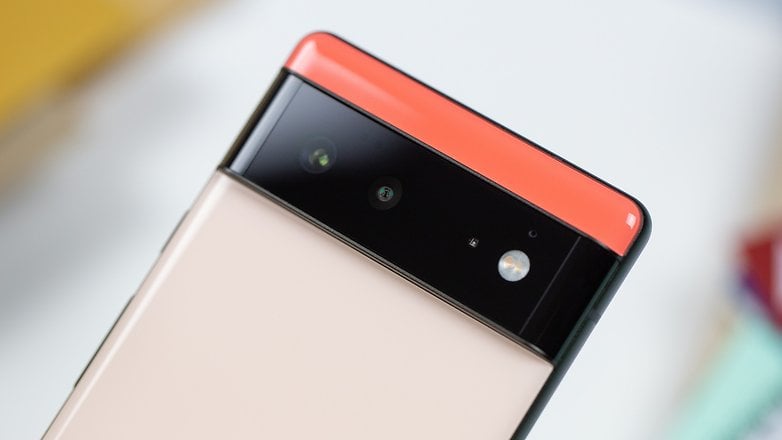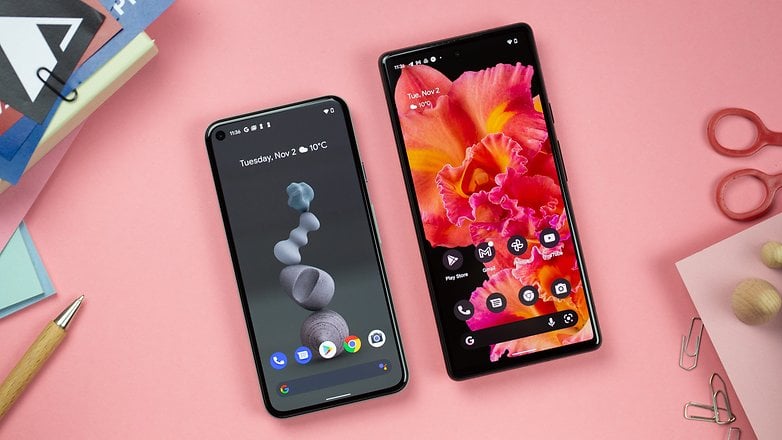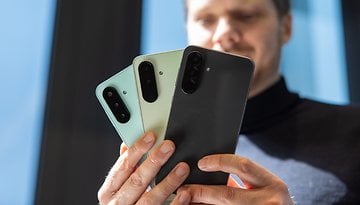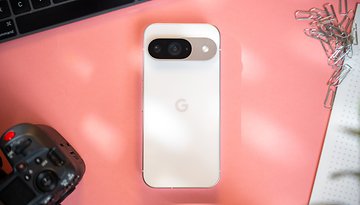Google Pixel 6 vs. Pixel 5: What changed between the Android flagships


Right at the center of a hype campaign that is fueled by the manufacturer itself, the Pixel 6 marked a radical change in the line of Google smartphones. However, what really changed compared to the previous generation? That's what we would like to show in this comparison between the Pixel 6 and Pixel 5.
The update of the Pixel line in 2021 changed the reference smartphone in the Android ecosystem both in terms of aesthetics and hardware, alongside highlights such as a new design, the debut of Google's very own Tensor processor, and a camera configuration that finally received a resolution upgrade.
Before we address the differences point-by-point (or should I say, pixel-by-pixel?), we've separated these two devices in a table to compare their respective technical specifications:
| Duel of the generations | ||
|---|---|---|
| Model | ||
| Image |  |
 |
| Screen | 6.4-inch OLED 1,080 x 2,400 pixels (411 PPP) at 90 hertz |
6.0-inch OLED 1,080 x 2,340 pixels (432 PPP) at 90 hertz |
| SoC | Google Tensor 2x ARM Cortex-X1 @ 2.80 GHz 2x ARM Cortex-A76 @ 2.25 GHz 4x ARM Cortex-A55 @ 1.80 GHz 20x ARM Mali-G78 (GPU) |
Qualcomm Snapdragon 765G 1x ARM Cortex-A76 @ 2.4 GHz 1x ARM Cortex-A76 @ 2.2 GHz 6x ARM Cortex-A55 @ 1.8 GHz Adreno 620 (GPU) |
| Memory (varies by region) |
8 GB LPDDR5 128 GB or 256 GB UFS 3.1 |
8 GB LPPDR4X 128 GB UFS 2.1 |
| Micro SD | n/a | |
| Main Camera | 50 MP | f/1.85 | 25 mm | 1.2 µm | 82° FoV | OIS (Samsung GN1 sensor: 1/1.31'') |
12.2 MP | f/1.7 | 27 mm | 1.4µm| 77° FOV | OIS |
| Ultra wide-angle | 12MP | f/2.2 | 16.3 mm | 114° FOV | 16 MP | f/2.2 | 16.5 mm | 107° FOV |
| Telephoto | n/a | |
| Video | 4K at 60 fps (rear) 1080p at 30 fps (front) |
4K at 60 fps (rear) 1080p at 30 fps (front) |
| Selfies | 8MP | f/2.0 | 1.12 µm | 84° FoV | |
| Audio | Stereo Speakers | |
| Battery | 4,614 mAh | 4,080 mAh |
| Corded charging | Max. 30 watts | Max. 18 watts |
| Wireless charging (Qi) | Max. 21 watts | Max. 12 watts |
| Pros |
|
|
| Cons |
|
|
| Ratings |
|
|
| Check out offers* |
|
|
Pixel 6 vs. Pixel 5: models and pricing
In addition to having a Pro version to the Pixel 6, Google has limited options in terms of availability where the smartphone is sold, not to mention colors and storage to boot. Overall, the traditional Pixel 6 is available in two storage versions versus just one for the Pixel 5.
Launch prices (abroad)
| Pixel 6 | Pixel 5 | |
|---|---|---|
| 128 GB | $599 | $699 |
| 256 GB | $699 | n/a |
The price was one of the most attention-grabbing points at the Pixel 6 launch. There was an expectation that using a top-of-the-line processor - in place of the mid-range Snapdragon 765G might make the device more expensive, along with the other upgrades, but that's not what happened.
In Europe, the 2021 model is only slightly more expensive than the Pixel 5, where in the United States, the Pixel 6 costs $100 less than its predecessor. Needless to say, it is not available in too many countries.
- Also read: How to pre-order the Pixel 6 and Pixel 6 Pro
Pixel 6 vs Pixel 5: Laser focus on the camera
Although the Pixel 6's biggest upgrade is probably in the SoC which we'll address later, the Pixel line has earned a reputation for its camera performance. Hence, it is worth kicking things off with the changes to the camera configuration of the last two generations of Google smartphones.

In addition to the completely new look of the camera module, the Pixel 6 brings different sensors and lenses from the predecessor, even while retaining the wide-angle and ultra-wide double combo of the Pixel 5. For the very first time in the family, Google has left the 12-megapixel main sensor behind, equipping the Pixel 6 with a 50-megapixel resolution shooter instead.
Unlike what you get in mid-range smartphones, the increase in resolution was also accompanied by a significant increase in sensor size. This goes a long way in explaining the different camera layout, but also the thickness of the camera module. The Samsung GN1 has a 1/1.31'' sensor, resulting in a reduction in the size of individual pixels from 1.4 µm (Pixel 5) to 1.2 µm (Pixel 6).

In reality, the Pixel 6 uses pixel binning feature to generate 12-megapixel images (with "2.4 µm" pixels), and the results are very good, something highlighted in the review by my colleague Antoine Engels, offering an impressive level of detail and good control of the dynamic range and colors.
In addition to the larger sensor, the computational photography capabilities of the Tensor processor bring unique features to the Pixel 6. For starters, there is the option to delete unwanted people and objects, a Motion Mode, and the Face Unblur feature which promises to bid goodbye to blurred faces in photos.
Pixel 6 vs Pixel 5: Debut of the Tensor SoC
Even with all emphasis placed on the camera, the Pixel 6's biggest leap over its predecessor is probably in the processor. In place of the mid-range Snapdragon 765G, here we have the Tensor SoC, a truly high-end processor that was designed by Google.
Despite having the same two Cortex-A76 cores as the Qualcomm chip, Tensor differs from the Snapdragon 765G by replacing two power-saving Cortex-A55 cores with two high-performance Cortex-X1 CPUs. As a result, it offers performance that is on par with the Snapdragon 888 chipset that is commonly found in most Android flagships of 2021.
Benchmarks
| Pixel 6 | Pixel 5 | |
|---|---|---|
| Geekbench 5 (single core/multi-core) | 1.031 / 2.803 | 578 / 1.574 |
| 3DMark Wild Life | 6.721 | 1.084 |
The performance difference should be more noticeable when it comes to heavy-duty tasks such as video processing, applying filters on high-definition images and especially in games, in which the Pixel 5 had a lower performance even than the Pixel 4 that was equipped with the Snapdragon 855 SoC.
For everyday tasks, the Pixel 6 leaves the Pixel 5 behind not only because of its more powerful CPUs, but also because of the UFS 3.1 storage standard which is newer and faster than the UFS 2.1 in the Pixel 5. Basically, you should experience faster app launch times.
Pixel 6 vs Pixel 5: screen and larger dimensions
| Pixel 6 | Pixel 5 | |
|---|---|---|
| Dimensions | 158.6 x 74.8 x 8.9 mm (105.58 cm³) |
144.7 x 70.4 x 8 mm (81.49 cm³) |
| Weight | 207 grams | 151 grams |
Another big difference between the two generations of Pixels, literally, is in the dimensions. The Pixel 5 looks like a compact smartphone next to its successor. The 2020 model's 6-inch screen gave way to a 6.4-inch display on the Pixel 6, influencing the devices' measurements.
The Pixel 6 is about 10% larger in height and depth and almost 6% in width, with a 37% increase in weight. The more generous dimensions allowed not only the use of a larger OLED screen (with equivalent resolution and refresh rate specifications), but also the use of a larger battery.

Pixel 6 vs Pixel 5: Battery and other differences
The Pixel 6's battery capacity stands at 4,614 mAh which is almost 13% larger than the Pixel 5's 4,080 mAh. Not only is the battery bigger, but the Pixel 6 is compatible with higher charging speeds, both wired (30 W vs 18 W) and wireless (21 W vs 12 W). Both smartphones offer wireless reverse charging, designed to power the charging case of Qi-compatible headphones, such as the Pixel Buds for instance.
Other important points to consider would be the new location of the fingerprint reader, which for the very first time is relocated to an under-display location as opposed to the rear of the case. For those who are concerned and particular about maintaining a symmetrical profile, there are changes made at the back with the camera with the display now featuring a centralized cutout for the selfie camera.
Conclusion
The Pixel 6 marks an important evolution for Google's line of smartphones, not only for the considerable leap in hardware specifications and camera features, but mainly for the adoption of a better and newer camera in addition to its very own processor. This means there should no longer be any performance issues associated with the mid-range Snapdragon chipset that saw action in the Pixel 5 and the Pixel 4a 5G/5a 5G.
What is even more important would be how the improvements were achieved without a radical change in pricing, where it also saw a price drop in selected markets. The model also gained an option with additional storage space albeit still without the possibility of expansion via a memory card slot.
For some people, however, the increase in dimensions and weight of the Pixel 6 (not to mention the even larger and heavier Pro version) can be a negative point for the new generation of Google's flagship smartphone. Sad to say, that seems to be an irreversible trend in modern day smartphones.



















